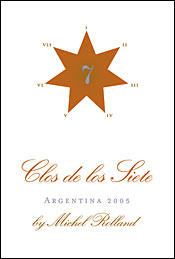When I taste Clos de los Siete, I can imagine that I am experiencing the infancy of a new grand cru. This wine has everything going for it that a first growth wine might need: a special vineyard, pedigreed ownership, and first-rate winemaking talent. It is a wine being built from the ground up with a spirit of discovery, and it somehow conveys a sense of destiny.
Clos de los Siete is winemaker Michel Rolland's 'project' in Argentina. His personal star power imbues the wine with instant status, even though the first vines were planted less than ten years ago and the third vintage of the wine has yet to debut. Rolland consults for more than 100 wineries around the world, but Clos de los Siete is his own: that is, he is one of seven owners of the estate (all of them French), and is the mastermind behind the venture. The individual owners each have - or will have, when the last winery is completed - his own winery, vineyard land and winemaker, but Rolland consults for all of them, and blends the final wine using varying portions of their individual productions. Having individual wineries and winemakers, Rolland says, brings individuality to the various wines and creates more complexity in Clos de los Siete. The stark simplicity of the label, which depicts a seven-pointed star and under the name of the wine says simply, 'by Michel Rolland,' belies the complexity of the operation.
 The total size of the collective property is about 850 hectares, 'about the size of Pomerol,' Rolland explains, but only slightly more than half of it is now planted. Malbec is the cornerstone of the vineyard and the wine, with half of the acreage; Cabernet Sauvignon and Merlot claim about 17 percent and Syrah represents about 12 percent of the vineyard. The wine is a blend of all these varieties. In 2004, the wine is 50 percent Malbec and 30 percent Merlot, with the balance divided between Cabernet and Syrah.
The total size of the collective property is about 850 hectares, 'about the size of Pomerol,' Rolland explains, but only slightly more than half of it is now planted. Malbec is the cornerstone of the vineyard and the wine, with half of the acreage; Cabernet Sauvignon and Merlot claim about 17 percent and Syrah represents about 12 percent of the vineyard. The wine is a blend of all these varieties. In 2004, the wine is 50 percent Malbec and 30 percent Merlot, with the balance divided between Cabernet and Syrah.
The premier vintage, 2003, is a bigger wine than this 2004, and the 2005 is bigger yet. (Rolland believes it will be the finest of the three, but at this young stage, and not long after bottling, the wine is very tight.) The 2004 growing season started off warm, and the Merlot ripened very early, but cool spells and cool nights then slowed the ripening of the other grapes, and the Syrah was harvested quite late, on April 22. As a result the wine has more finesse and delicacy, and less density and concentration, than the other two vintages. This is good news for those of us who prize restraint.
But this wine is no wimp. It's full-bodied, totally dry, relatively lean, and it has a moderate amount of fine tannin all through its texture. Aromas and flavors suggest smoke, black pepper, spice, dark plum, and blackberry, and all of these contribute to a substantial, firm fruitiness. In a Burgundy-style glass, slight herbal notes emerge, suggestive of garrigue. This wine claims the middle ground between a powerful red and a gentle red, and has lots of presence. With food, it transforms into a smooth, round, soft wine that is a pleasure to drink.
Rolland believes that all three vintages of his Clos de los Siete wines have seven or eight years of life ahead of them, and maybe more. I, for one, will be following them, so that I can say that, 'I was there when.'
91 Points